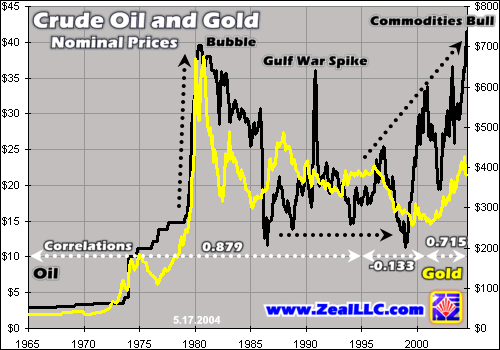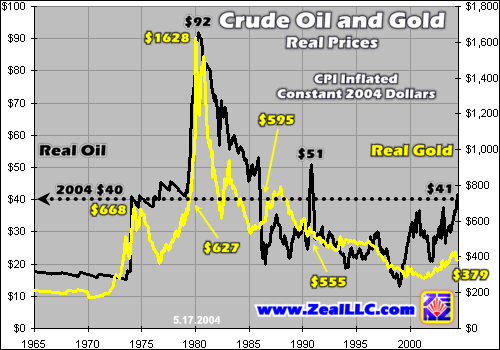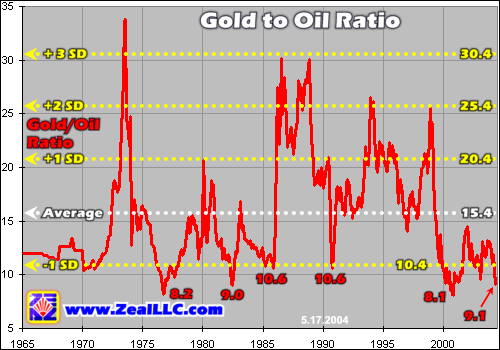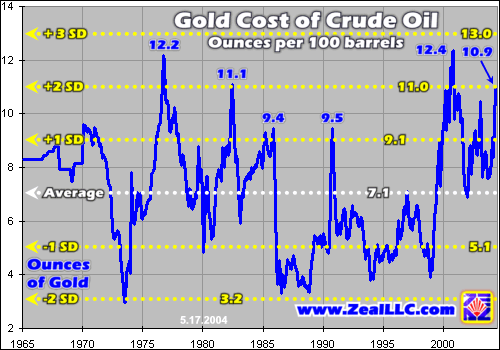Gold Boiling in Oil 3
Adam Hamilton May 21, 2004 3767 Words
Following its new all-time-record-high closes this week, crude oil is again very much in the news these days. Energy companies and speculators are rejoicing, Wall Street economists are worried, consumers are wailing, and opportunistic politicians are gunning for blood.
While the endless phalanx of media stories trying to convince Americans that oil has never been higher are true in a strict sense, they are heavily biased and not really accurate. Yes, nominal oil prices are probing new all-time highs, but in the proper inflation-adjusted real terms oil is nowhere close to eclipsing its all-time highs witnessed 25 years ago.
All investors and speculators are affected to some degree by the current bull market in oil, if for no other reason than higher oil prices retard consumer spending and therefore slow down corporate-profit growth. Financial television networks like Bloomberg and CNBC have devoted a great deal of air time to the potential impacts of higher oil on stock and bond investors.
Unfortunately, however, I have not yet seen any mainstream discussions on the bullish ramifications of higher oil prices for gold investors. Just like any other underappreciated contrarian sector, the precious metals remain largely overlooked and ripe with vast opportunities. This week I would like to examine gold relative to crude oil.
I originally wrote about this crucial relationship between gold and oil four years ago in “Gold Boiling in Oil”, and updated this analysis two years later in “Gold Still Boiling in Oil”. Both of these studies showed that the gold bull was lagging the oil bull, which was very bullish for gold since the Ancient Metal of Kings would probably catch up with oil sooner or later based on historical precedent.
The analogy I used was one of ice-cold gold bars sitting in the bottom of a massive cauldron of oil. As the oil markets heat up, stoked by the fires of insatiable global demand for energy, oil prices are beginning to boil. As these oil prices rise, however, they put a great deal of pressure on gold prices to march higher. Gold cannot remain cold and out of favor for long while oil is boiling hot all around it.
Our updated graphs this week highlight the immensely strong positive correlation between these two elite commodities. After starting with the conventional but inherently flawed media view of nominal prices, we will delve into the real inflation-adjusted gold and oil prices. After the real state of the oil and gold markets becomes apparent, we will analyze key gold and oil ratios and their bullish implications for today’s precious-metals investors. Gold continues to boil in oil.
This first chart is the one that Wall Street and the financial media are currently dwelling on, gold and oil in nominal prices. The careless misuse of multi-decade commodities charts not adjusted for the perpetually declining value of the fiat US dollar really bothers me. This perspective is greatly distorted in purchasing-power terms and serves only to obscure the truth and stoke alarmism.

While gold is only halfway to its all-time highs in monthly-closing nominal terms, crude oil is breaching new all-time highs. The average American who is not fortunate enough to have the background necessary to understand why this chart is misleading will hear about these new oil highs on the news and be easily manipulated for political purposes.
Even though this widely trumpeted chart is distorted, however, it does still retain analytical value when viewed in its proper perspective. Visually, you can easily see the very high positive correlation between oil and gold. When oil is charging higher, gold tends to march right alongside it in lockstep. Indeed, the mathematical correlation of this monthly data bears this out, with the entire dataset running at a positive 0.839 correlation over nearly four decades.
If we divide this chart into segments, the correlation analysis becomes far more provocative. From 1965 to 1994, the monthly correlation between gold and oil weighed in at a very impressive +0.879. From 1995 to 2000, however, this correlation seemingly vanished with a negative 0.133 reading.
This late 1990s anomaly is very interesting since it coincides with both a supercycle equity bubble and all kinds of official central-bank interventions designed to manage the gold price. Central-bank activity in gold tends to wax the most extreme leading into major long-term gold bottoms and indeed that is what we witnessed entering this new millennium. Since 2000 though, the historical oil and gold correlation has been restored, now again running positive at +0.715.
Another interesting observation on this nominal chart is the technical shape carved by prior highs in crude oil. During the commodities bubble of the late 1970s, oil shot vertical to nearly $40 per barrel. Naturally, like all vertical ascents, this sharp move was inherently unsustainable and soon decayed lower and collapsed. A similar sharp spike happened in 1990 when Washington first declared war on Iraq. This too rapidly vaporized, as it was another vertical move too fragile to persist.
Our current all-time nominal oil highs, however, sport a very different technical character. Rather than a vertical spike, we are now in a major bull market in oil that has been running strong since the late 1990s. Oil has marched relentlessly higher in a beautiful series of bull-market uplegs rather than a single blistering spike, and this healthy technical profile makes today’s prices look far more sustainable than the previous two long-term oil highs.
The single most important point of this chart is the long duration of our current oil bull. It never ceases to astound me how many folks today want to blame high oil prices solely on terrorism and Iraq. While these headline geopolitical tensions are definitely bullish for oil, they are certainly not the whole story by any means. When our current oil bull launched way back in late 1998, George Bush the Younger wasn’t even President yet. September 11th was 33 months away and Washington’s annexation of Iraq was 51 months into the future!
Oil is not in a bull market today simply because a bunch of bored Jihadists are enjoying messing with Washington, but because of a long-term fundamental supply and demand shift. The great nations of Asia, primarily the giants China and India, are growing rapidly and need to vastly increase their energy consumption to build out their infrastructure and bring their lifestyles closer to Western standards. And since much of the world has already been explored for crude, there just is not enough new oil coming online to feed both the industrialized West and the industrializing East.
With rapidly rising demand far outstripping slowly growing supplies, the only possible economic solution is for crude oil prices to continue to rise. Higher prices decrease global demand by discouraging consumption while at the same time providing incentives for oil producers to pump more oil and increase global supply. Eventually this will stabilize oil prices at some new higher level. The fundamental seeds of this secular oil bull go far deeper than mere geopolitical tensions.
Perspective is everything for investors and speculators, and this nominal chart greatly distorts what is really going on with oil and gold. Having the wrong perspective on the prevailing long-term trends will lead to poor trading decisions and slaughter investors every time. My favorite illustration of the critical importance of perspective is the awesome Biblical account of the great prophet Elisha and his servant at Dothan.
In ancient Israel, Elisha was greatly enraging the king of Aram by using his God-given revelations of the Arameans’ secret battle plans to warn the king of Israel in advance. The king of Aram ordered his army to track down and capture Elisha so the Israelis would have no more advance warning of the Arameans’ war campaigns. This narrative picks up in the second book of Kings with the Aramean army surrounding the city of Dothan, where Elisha was staying…
“Then [the king of Aram] sent horses and chariots and a strong force there. They went by night and surrounded the city. When the servant of the man of God got up and went out early the next morning, an army with horses and chariots had surrounded the city. ”Oh, my lord, what shall we do?” the servant asked. “Don't be afraid,” the prophet answered. “Those who are with us are more than those who are with them.” And Elisha prayed, “O LORD , open his eyes so he may see.” Then the LORD opened the servant's eyes, and he looked and saw the hills full of horses and chariots of fire all around Elisha.”
Elisha’s servant lacked perspective. He was scared when the Aramean army surrounded him and Elisha. It wasn’t until God opened his eyes that Elisha’s servant realized that God’s own army, chariots of fire, were protecting him and his master from the invaders. I believe that investors and speculators, if they are not considering oil and gold in inflation-adjusted real terms, are as blind and hopeless as Elisha’s servant.
When only considering the nominal chart above, $40 oil looks like a very strong long-term resistance line. It would be easy for investors to consider $40 oil an anomaly that just has to collapse to lower prices. This flawed perspective suggests oil, and therefore gold, are likely to head much lower soon. Like Elisha’s servant before his eyes were opened, however, this myopic perspective totally misses the grand strategic picture.
Our next chart is the same monthly oil and gold data in real terms, with historical prices inflated to today’s 2004 dollars using the US Consumer Price Index. Today’s all-time nominal oil highs that looked so impressive above utterly pale in comparison to oil’s real all-time highs of decades past. This real inflation-adjusted perspective is crucial to understanding the current oil and gold situation.

Thanks to the US Fed’s relentless inflation of the US dollar, a dollar today will go much less farther than a dollar 25 years ago. Nominal prices of everything important for living, from food to energy to clothing to cars to houses to education to health care, are rising all around us as relatively more US dollars chase relatively fewer goods and services. Long-term commodities markets can only be really understood through the true strategic perspective of monetary inflation.
Prior to Washington’s destruction of the dollar gold standard in 1971, real oil prices were gradually falling for decades. Every year it cost the average American family a smaller percentage of their income to fuel their cars. In today’s 2004 dollars, a barrel of oil only cost about $16 before Nixon reneged on the golden limit to the Fed’s fiat-currency inflation! Since that fateful day of infamy, however, oil prices have soared right along with the US money supply.
Oil first hit $40 per barrel in today’s dollars in early 1974. It then meandered near $40 for a half decade before shooting up with most other commodities in the great commodities bubble of 1979. Oil’s real all-time monthly high in constant 2004 dollars was a breathtaking $92 per barrel witnessed in April 1980! $92 per barrel obviously makes today’s $41 level look pretty anemic and not at all threatening or unique within history.
Whenever the media stokes public discontent with alarmist oil stories about $40+ prices, it always irks me because $40 oil today is relatively cheap by past-decades’ standards. Interestingly, this is just slightly above average. In real dollars over the past three decades the average monthly oil close ran near $38 per barrel. In 2004 dollars we have been paying an average of $38 for the past three decades, so no one should be complaining about oil prices today.
Following its all-time highs of 1980, oil ground lower before abruptly crashing in early 1986. It did not exceed $40 again until the spike of the First Gulf War, when it soared to $51 in 2004 dollars. This quick and unsustainable rally soon collapsed though, leading to a brutal oil bear market that did not end until late 1998 at all-time real oil lows of $13 per barrel in today’s dollars.
Thus the real perspective on oil is far different from the nominal picture. Relative to our incomes and general price levels, oil is not at all expensive at $41 today and would have to charge a great deal higher to come anywhere close to threatening true all-time record highs. Like Elisha’s servant, however, it takes a real chart to open our eyes to this market truth. The media’s obsessive focus on today’s nominal oil highs without considering inflation is reckless and really distorts the current situation.
This real chart also offers all kinds of interesting technical insights on oil and gold. First, note the black reference line drawn above at $40 oil in today’s 2004 dollars. Every five years or so from 1974 to 1990, oil tended to cross above or below $40 real. Interestingly, all of the gold prices, also in today’s 2004 dollars, were far higher than today’s at these historical $40 oil intercepts.
As these $40 oil intercepts happened, gold was trading at $668, $627, $595, and $555, for an average price of $611 or so. With gold languishing near $380 today, it is only about 62% as high as it has been at past $40 oil intercepts. Gold ought to be trading far higher today relative to our latest $40 oil intercept.
Also intriguing in a technical sense in this real chart are the bull-market patterns of both oil and gold. Today’s oil bull, which looked fairly steep in the first chart in nominal terms, looks quite normal and unremarkable from a real perspective. It is a textbook-perfect series of higher highs and higher lows characteristic of a long-term bull market driven by underlying fundamental forces. There is no panic evident in this real chart.
Gold’s current bull market looks incredibly modest in real terms as well. As comparisons with the past gold bulls of the 1970s and mid-1980s indicate, the real upslope in our current specimen is not at all extreme or out of control. In fact, gold is seriously lagging oil in real terms and will have to rally sharply from here to catch up and preserve the integrity of its strong historical relationship with crude.
How high could gold go to catch up with the oil bull? Our next two charts offer some insights. The first, the gold-to-oil ratio, simply divides the price of gold by the price of oil so we can see their relationship unfold over time. The second chart, the gold cost of crude oil, reveals how many ounces of gold it has taken throughout modern history to buy 100 barrels of oil.
For you analysts who want to replicate this research, these next two charts are identical when graphed in either real or nominal terms. Since the inflation adjustment affects both gold and oil equally, the nominal and real ratios match perfectly. The current implications of these analytical tools for gold investors are very important.

Both of these charts have averages and standard-deviation lines drawn in to help illustrate the magnitude of the extremes in the past few decades or so. Since 1965, the average ratio of the price of gold to the price of oil has been 15.4, an ounce of gold averaging 15.4x more expensive than a barrel of crude oil. If we take today’s oil price of $41 per barrel, and multiply it by 15.4x, we get a projected gold price of $631 today. Interestingly this is right in line with the $611 $40-oil-intercept average discussed above.
But this approach using today’s oil prices is not particularly conservative. Although oil is in an undisputable secular bull driven by powerful fundamental forces, even bull markets experience periodic pullbacks. Today oil’s key 200-day-moving-average support is running near $33, while its linear lower support line of the past few years is hovering near $32 now. If oil temporarily pulls back to this long-term support, $32 is a very conservative number to use to plug into this ratio.
At $32 oil in the depths of a bull-market correction, the 15.4x historical average yields a target gold price of $493, far above today’s gold levels. Any way you want to slice it, in light of gold’s historical relationship to oil gold is way undervalued at its current levels near $380. Gold is significantly lagging the oil bull and will almost certainly catch up sooner or later here to bring this key gold-to-oil ratio back in line.
Another interesting aspect of this ratio becomes readily apparent when you examine the bottom of this chart. Prior to the last few years, the average long-term support for the gold-to-oil ratio ran 9.3 or so. Today with oil so high relative to the lagging gold price, this ratio is even lower at 9.1. Historically this is right at the major long-term support that often witnesses a sharp bounce higher in the gold-to-oil ratio.
And as markets revert back to their averages from extremes, these mean reversions almost always tend to overshoot the average on the other side. Mean reversion is one of the most important principles of the long-term markets. In light of this strong tendency, shooting for a 15.4 ratio is probably very conservative. Since we are now under 1 standard deviation below the average, it would not be at all surprising to see this ratio rebound and mean revert back up to at least 1 SD above its long-term mean. The average position of a swinging pendulum is in the middle of its arc, but it seldom stops there.
The gold-to-oil ratio at +1 SD is about 20.4, so $32 oil plugged into this ratio would yield a gold target of $653 per ounce. While these targets are rough and are certainly not intended to be precise trading targets, they do help to illustrate just how far out of whack the gold and oil relationship is right now. And as all other extremes in market history tend to be fleeting before norms are reestablished, so too will this one probably be short-lived.
Our final graph looks at this gold and oil relationship from a different perspective, how many ounces of gold one would have to spend throughout modern history to buy 100 barrels of crude oil. As discussed in “Gold Still Boiling in Oil” a couple years ago, this perspective is most relevant to oil producers selling their product. Just like the gold-to-oil ratio above, the gold cost of crude oil is also near historic extremes that are probably not sustainable.

Over the last four decades or so, it has cost about 7.1 ounces of gold on average to pay for 100 barrels of crude oil. This comparison is important as it takes the perpetually inflating fiat dollars out of the equation and directly compares these two physical commodities sans dollar distortions. As you can see above, all the other moments in history when oil became this expensive in gold terms proved to be short-lived.
Every single extreme high gold cost of crude, ranging from 9.4 ounces to 12.4 ounces, was followed by a sharp and abrupt plummeting of the gold cost of oil. Today’s 10.9 ounces reading is very high and right in this historical top resistance range, not to mention being stretched two standard deviations above the average. Naturally there are two ways that this number can contract and mean revert, oil can fall or gold can rise. I expect that we will probably see both over the short-term.
Assuming that oil is due for a healthy correction back to its long-term support in its secular bull, 100 barrels of crude oil could cost $3200 again before oil marches higher. If this ratio were to mean revert and not even overshoot, the 7.1 ounces of gold required to buy these barrels of oil at $32 would be worth about $451 per ounce. Once again even using conservative numbers the projected gold price based on current oil levels, even in a major correction, is far higher than today’s prevailing gold price.
And unsurprisingly, if we use less conservative assumptions, the outlook for gold is even brighter. If oil did not correct back down to its long-term support and the gold cost of crude mean reverted back down through and below its 7.1 ounce average, the projected gold price would be far higher. At a crude price of $40 per barrel and a gold cost of 5.1 ounces per 100 barrels, for example, the gold price would weigh in at $784.
Now once again I have to really stress that these numbers are not specific gold trading targets. The important point to realize is strategic and fundamental!
Oil is in a long-term bull market, and it has been marching relentlessly higher for years even before Washington’s annexation of Iraq and 9/11. Global oil demand is growing far faster than global supply, so oil prices have to rise to clear the market. This is how the free markets always work to remedy a chronic supply/demand imbalance.
Like oil, gold is also in a secular bull market. But the Ancient Metal of Kings has been lagging oil significantly. This has skewed all the historical gold and oil relationships to extremes that are not sustainable. Since oil demand from the industrialized West and the industrializing East is not likely to abate, and gold tends to move strategically with oil throughout history, the gold price needs to move much higher in the years ahead to keep pace with oil.
Even today, gold continues to boil in oil. The strong oil prices are putting a great deal of pressure under the gold price and will continue to help the gold bull accelerate. In order to capitalize on these fantastic opportunities in gold, we continue to carefully pick and recommend elite gold and silver stocks in our acclaimed monthly Zeal Intelligence newsletter for our subscribers who graciously support our research work.
Before this gold bull gives up its ghost, great fortunes will be earned by prudent contrarian investors and speculators. Will you be one of the big winners?
As the great commodities bull marches higher, it is crucial to realize that the media’s alarmist nominal price comparisons over decades of history are very misleading and full of distortions. Today’s oil at $40, and gold under $400, are not even close to high by any real historical standard.
Like Elisha’s servant, sadly most investors are blinded to the fantastic commodities opportunities since they have no information other than the mainstream media’s nominal-all-time-record-high-oil alarmism. From the true inflation-adjusted real perspective, gold and oil are just getting started.
Adam Hamilton, CPA May 21, 2004 Subscribe at www.zealllc.com/subscribe.htm
![]()